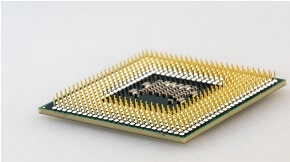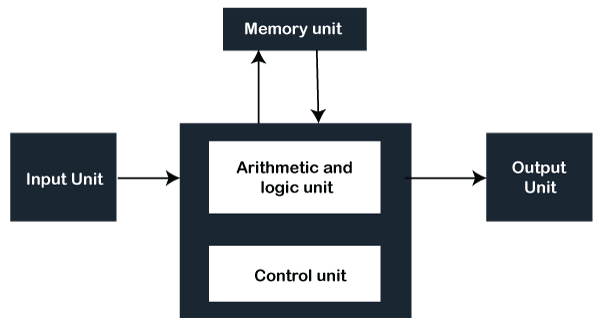Fourth Generation of ComputerThe computers made in the fourth generation were based upon the microprocessor, which was the extended version of the third generation of computers. These computers used VLSI circuits, and the time period of this generation was 1971 to 1980. On a single chip, VLSI and LSI techniques are contained by a microprocessor to pack millions of transistors. VLSI short for Very Large-Scale Integration, and LSI stands for Large Scale Integration. In modern times, the speed and memory of computers have enhanced drastically while the cost and size have dramatically decreased. The characteristics of the fourth generation of computers was that associated with the process of creating an integrated circuit (IC) with the help of combining many transistors into a single chip because these computers used the VLSI technology. For instance, due to the technology used to build fourth-generation computers, they came with various features such as more versatile, large primary storage capacity, excellent in speed and reliability, portable, very compact and small, etc. In this generation, computers have become more popular as they are sold at the lowest price. Additionally, the personal computer (PC) revolution also developed because of the features of fourth generation computers. The below image is an instance of the microprocessor. 
The first processor was Intel 4004 that was built on a single silicon chip, which was built in 1971 and included 2,300 transistors. It gave a new rise to the generation of a computer whose lineage would be continued in the present. In 1981, IBM chose the Intel Corporation as the builder of the microprocessor (the Intel 8086) for IBM's new machine, the IBM-PC. Around 240,000 additions per second can be executed by the new IBM machine, the IBM-PC. However, in terms of speed, this computer was much slower as compared to the computers in the IBM 360 family. But it became the reason to grow the personal computer market and its cost was only $4,000 in today's dollars. Later in 1996, the PC, Intel Corporation's Pentium Pro was very fast in speed; it had the capability of executing 400,000,000 additions per second, which was approx 210,000 times fast comparing to the ENIAC-the workhorse of World War II. The cost of the machine is only $4,400 in dollars. In modern times, all computers are basin on microprocessor technology. The manufacturing of chips is not costly. Memory chips and processor chips both are different; memory chips are used for dynamic RAM (random access memory), and processor chips are used as a central processor. The millions of transistors are used in both kinds of chips (Memory and processor chips). The chips can be available in the future through which memory and processor chips can be combined on a single silicon die. Due to a lot of transistors can be concentrated in a very small place, Superscalar, cached and pipelined microprocessors became popular that allowed scientists to exploit instruction-level parallelism with the help of instruction pipelines along with designs, which made it capable of executing more than one instruction at a time (called superscalar). Also, scientists became capable of designing these single-chip processors with onboard memory, which is known as a cache. The Intel Pentium Pro PC was known as for pipelined, cached, superscalar microprocessor. Also, the use of parallel processors has increased during this period. In order to results in parallel, these machines integrate multiple processors in different ways. Now, they are used for file servers and as well as databases; however, they have also been used for scientific computations. They still may not lend themselves various problems to a parallel solution and very hard to program because they are not as universal as uniprocessors. It has been said that if there had improvements in the airline industry at the same rate as the computer industry, one could travel from New York to San Francisco in 5 seconds for 50 cents. The performance of microprocessors was improving at a rate of 55 percent per year in the late 1990s. If that improvement not stops and does continue, it will be right to say that at the dawn of the twenty-first century, in Silicon Valley, all the computing power of all the computers could be possessed with the help of a single microprocessor. Some other examples of fourth generation computers are included: IBM 4341, DEC 10, STAR 1000 and PUP 11. Architecture of Fourth Generation ComputersThe five independent units Input, arithmetic and logic, memory, output and control unit are included in the computers made in the fourth generation. The below diagram represents the physical location of computer's functional unit in the computer. The unit takes input (digital information) by users with the help of input devices such as mouse, keyboard, microphone, etc. The input is processed or hold on the basis of the kind of instruction. 
Features of the fourth generation of computersThe computers made in the fourth generation have numerous characteristics, which are as follows:
Advantage and Disadvantages of Fourth Generation ComputersIn the beginning, only around ten to twenty components were contained by the integrated circuits technology, which was known as SSI (small scale integration). Later, it became possible to combine hundreds of components on a single chip with the development of advanced technology in the field of ICs, which was known as medium scale integration (MSI). With time, combining more than 30,000 components onto a single chip became possible. The effort is still continued for further advanced technology with the expectation that there will be developing technology that would integrate over millions of components on a single chip, which is called very-large-scale integration (VLSI). The computers of the fourth generation contain LSI chip technology as their brain. The help of this technology made it possible to manufacture extremely powerful computers as well as very small in size. That led to a social revolution in the computer field. With the size of a postage stamp, on a single ship, an entire computer circuit was soon available. Later, it became possible to make a computer for everyone as the cost of manufacturing them became inexpensive.
Next TopicFifth Generation of Computer
|
 For Videos Join Our Youtube Channel: Join Now
For Videos Join Our Youtube Channel: Join Now
Feedback
- Send your Feedback to [email protected]
Help Others, Please Share










